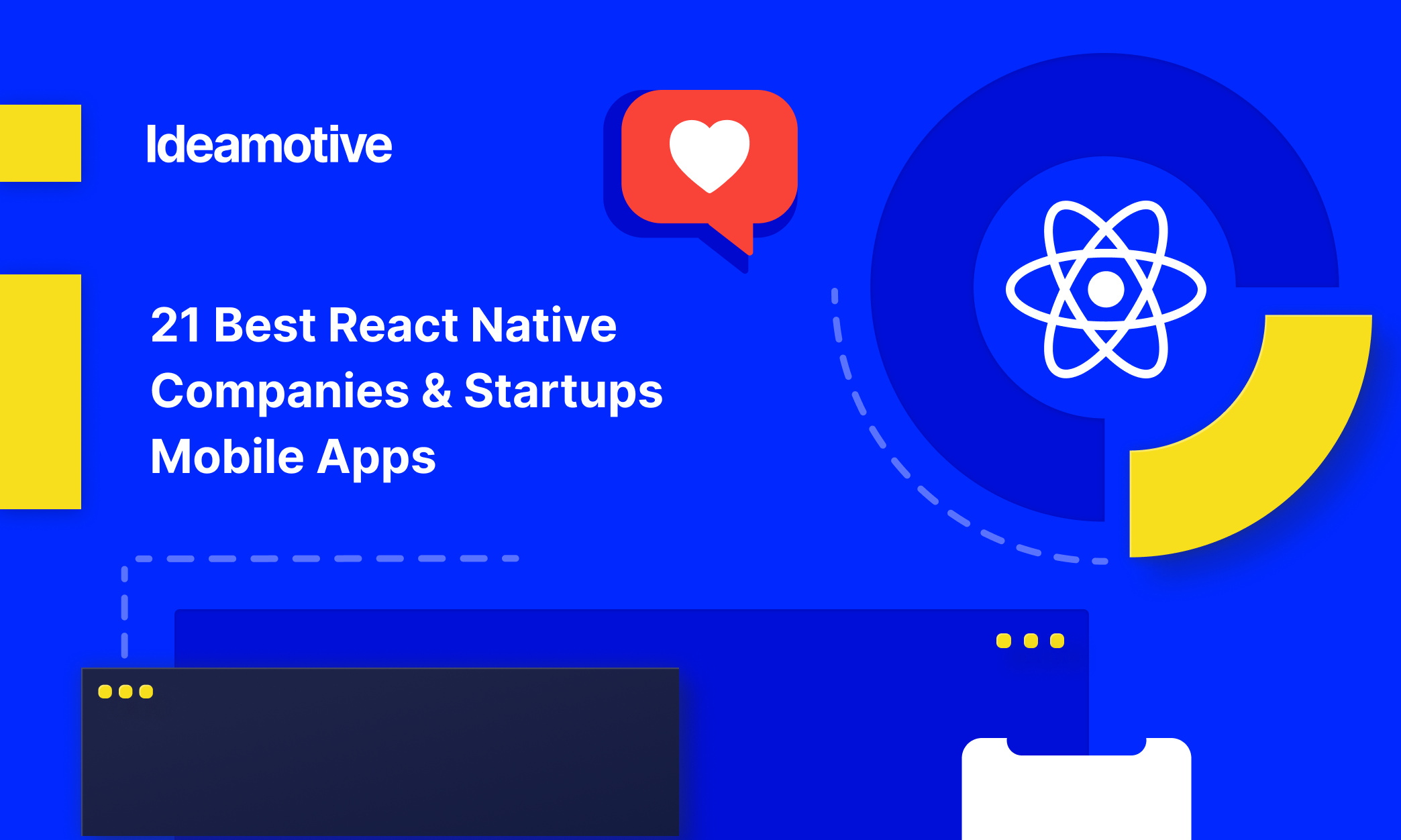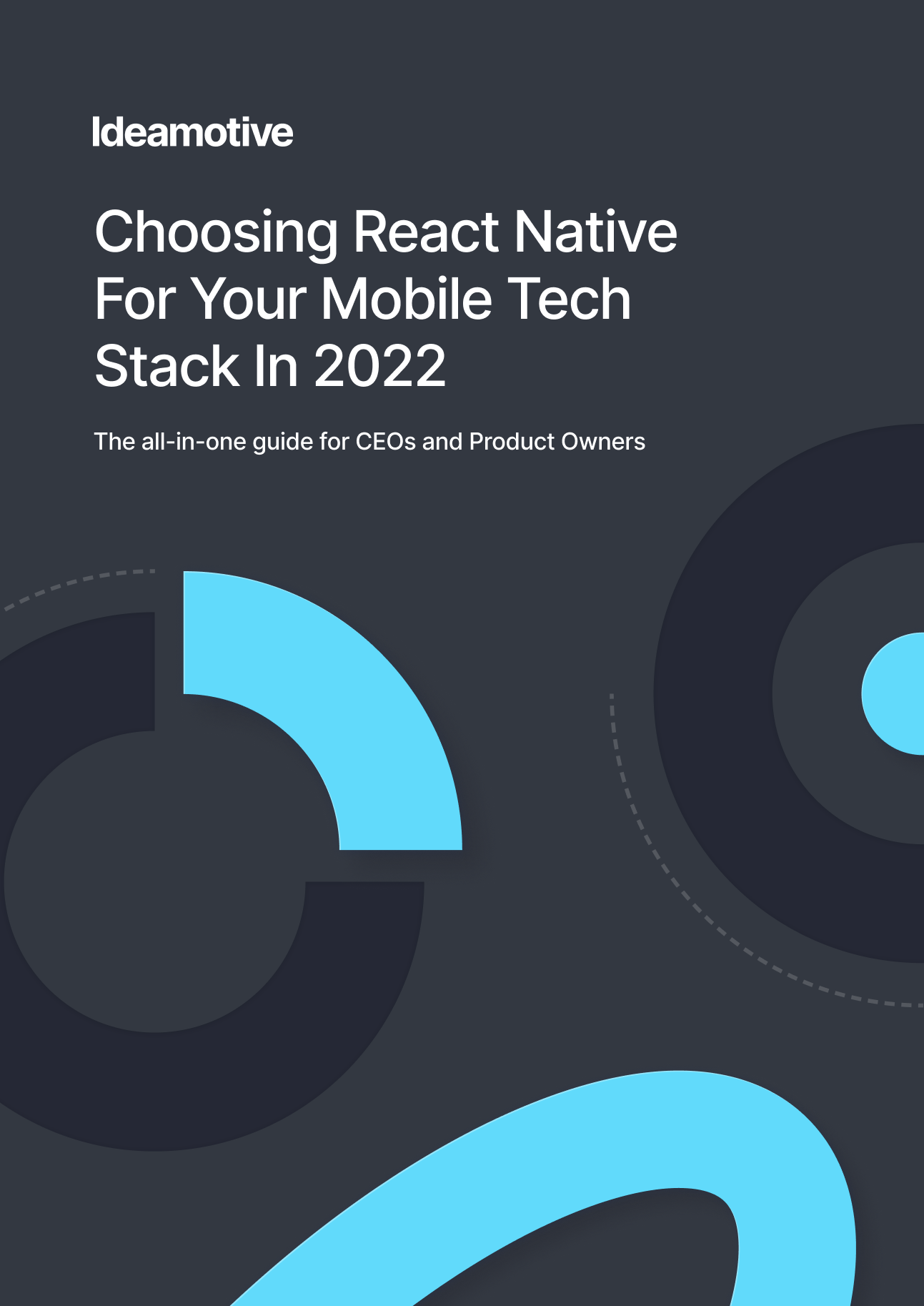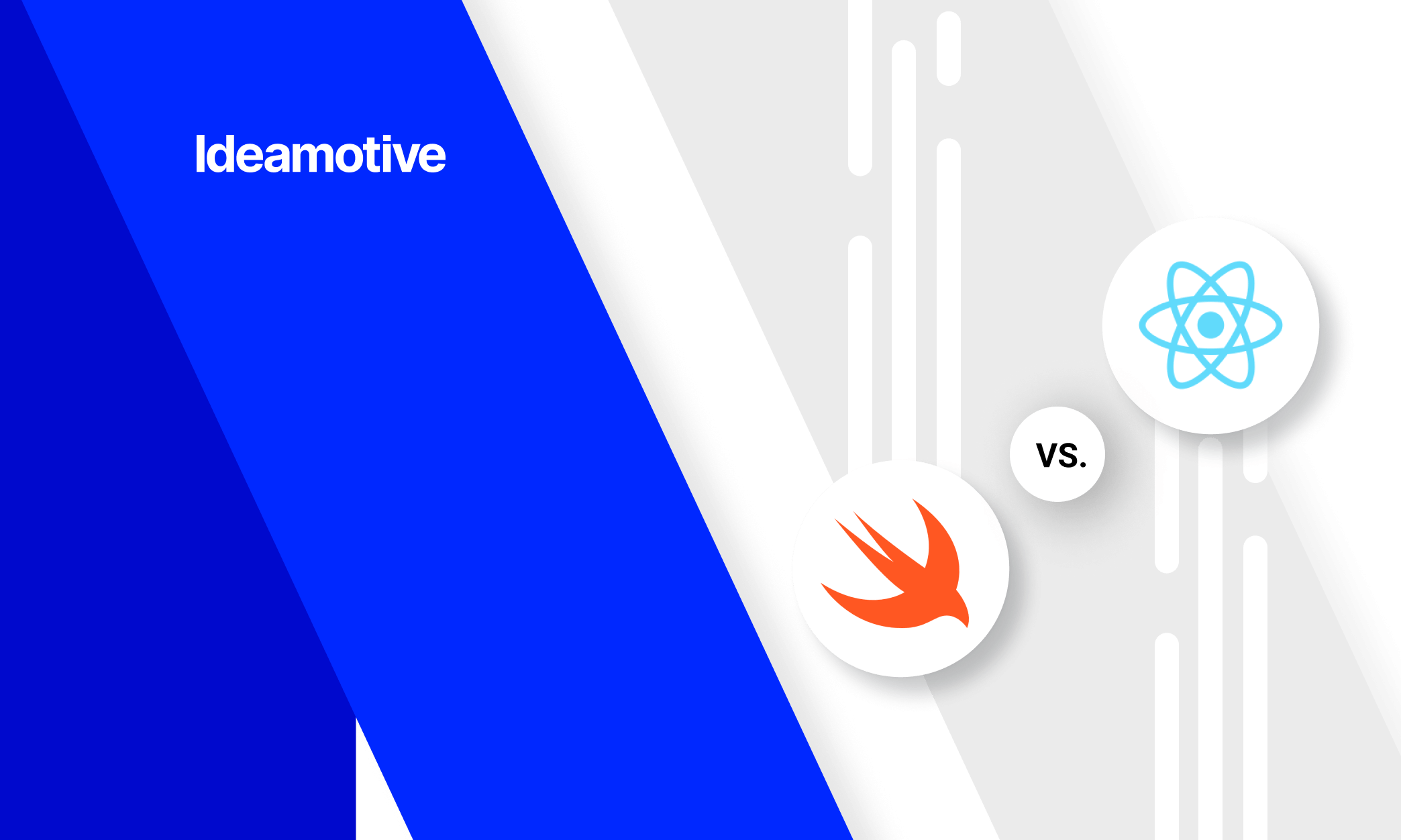21 Best React Native Companies & Startups Mobile Apps [2023 UPDATED]
Feb 19, 202217 min read

Michał Rejman
Chief Marketing Officer of Ideamotive. Travel addict and remote work advocate.

As of 2023, React Native stands as the premier framework that truly delivers on the commitment of cross-platform native app development. Despite being relatively new to the tech scene, it has been effectively adopted by businesses ranging from fledgling startups to large corporations across diverse sectors. This underscores its versatility and the growing confidence in its ability to facilitate robust mobile application development.
To put it simply, React Native combines the advantages of native and hybrid apps. On average, iOS and Android versions of the same app share 60-70% of the codebase, which speeds up the development process significantly. On top of that, it gives a native-like user experience.
But why do big players like Discord or Walmart decide to leverage React Native in their mobile apps? Read their stories to find out and to get inspired!
Want to know even more about React Native mobile app development? We put together this all-in-one guide about our favorite mobile development framework 👇
Why React Native is a great pick for mobile development
The list below was created based on the experience of different React Native development companies. It will give you a complete understanding of RN’s capabilities. We divided them into two groups - pros from a business perspective and from a development perspective.
Pros from a business point of view
- Development speed and cost. What native app development companies love about React is that they can reuse and recycle components that they have previously developed. Also, here we have a great React Native ecosystem, where native app development companies can share their codebase and make it work faster.
- Turn web projects into mobile apps. The work done on this platform is easy to understand and anyone can get around it, even if they haven't done it before. This increases flexibility and makes web updates consistent.
- User experience. As long as you don't use extremely complex designs and interactions, or create a heavy game, you can still create high-performance apps with absolutely great user experience.
- Faster time to market. You can get to market much faster to test your MVP, get feedback, and adapt accordingly without the need for a large investment.
- On-demand help. The React Native mobile app development community is huge. Many of the problems that you may encounter during development may already be fixed somewhere out there. This factor significantly reduces the costs.
- Maintenance cost. You are only dealing with one codebase. Moreover, it’s easy to host apps in the AppStore and Play Store. Unlike PWA.
- Smoother and faster interface compared to classic hybrid ones. The interface built with React Native is very responsive and flexible.
- Over the air (OTA) updates. Allows you to send quick fixes directly to users without waiting for the app store or Google Play to accept our changes.
Pros from a development point of view
- Easy to work with. Experienced developers will definitely appreciate the mobile app development experience. Meaningful error messages, time savings, and robust tools make it a top choice over other platforms.
- Changes preview. You don't have to rebuild your app over and over to see your changes. This saves a lot of time and makes work fast and efficient. Press Command + R to refresh the app.
- Fast iteration loops that just add more value.
- Intelligent debugging tools and error reporting mechanisms. Give it an edge over others and allow developers to focus more on the productive part.
- Easier to debug. Flipper is used by default.
- Keep things minimal and decent. It doesn't force you to work in Xcode or Android Studio for iOS or Android apps, respectively.
- A large community of developers who contribute day in and day out.
- Code reusability. Native app development companies can easily integrate 90% of the native framework and reuse code for any platform. This feature not only saves time, but also helps reduce the cost of building two applications. The cool thing is that you can use web app code (written in React) for mobile apps.
- Pre-designed components. Numerous open source libraries are available to speed up your work.
- Live reload feature. Helps compile and read the file from where the developer made the changes. A new file is then presented to the stimulator, which automatically reads the file from the beginning.
- Compatible with third party plugins and does not require a lot of memory for processing. No special web views functionality is required and native modules are linked to the plugin via the framework. The key features of this device are smoother running and faster loading.
- Expo is a great tool for quickly developing applications for many platforms with many ready-made libraries in the SDK.
- One codebase for all. The ability to store only one codebase to run a project in Android, iOS and a web browser.
- Demo Mode. When using Expo, you can create a demo for the client without submitting your app to Testflight or the Google Store. The only thing we need is the Expo app on a mobile device.
Cons
- Performance is still lower than native. React Native cannot take full advantage of the benefits and potential of a particular platform. On the other hand, native apps can really maximize functionality and, as a result, provide the best user experience. However, the refactoring is putting a lot of effort into making RN more performant, such as a new JS engine, Hermes, which allows applications to run much faster on older Android devices.
- Ineffective design. If you consider complex design or extended interactions to be an important part of your business advantage, you should definitely do your own mobile app development.
- Custom modules. Many custom modules are already available, but there may be some specific component needs that you will have to create from scratch yourself.
- Upgrade issues. It's hard to keep your app updated to the latest version of React Native all the time. Updating RN versions in most cases is a complex process.
- If you are building a web app using React Native, you need to ditch all libraries that use native modules.
1. Facebook – React Native creators
For obvious reasons, Facebook has to be mentioned first. React Native was created by this social media giant during one of their hackathons and they are the main force behind the development of this framework.
The goal was to bring advantages of web development, such as short iterations into mobile development. Originally, React Native was used in the iOS version of the Facebook app but now it provides UI for Android as well. The idea of having one React development team instead of two also played a significant role.
React Native based parts of the app are constantly being optimized. For example, the Event Dashboard performs twice as fast as at the beginning.
“React Native allows you to build iOS and Android apps in JavaScript using React and Relay‘s declarative programming model. This leads to more concise, easier-to-understand code; fast iteration without a compile cycle; and easy sharing of code across multiple platforms. You can ship faster and focus on details that really matter, making your app look and feel fantastic. Optimizing performance is a big part of this.”
Pieter De Baets, Software Engineer at Facebook
2. Facebook Ads – first cross-platform React Native app
The Facebook app wasn’t the first one created with React Native – it was a Facebook Ads app. Initially released on Android (then on iOS), it was the first cross-platform app in the history of React Native development.
Facebook Ads app allows users to run and overview paid marketing campaigns from the smartphone level. It is an extremely useful tool for online marketers around the world.
React Native was a perfect match for this app. It's extremely complex, as it deals with various ad formats, currencies, forms of payment and time zones.
Overall, the dev team delivered a delightful user experience and proved that React Native can be successfully used in cross-platform development. You can read more about it on the Facebook Dev Blog.
3. Instagram – Integrating React Native into an existing native app
Instagram needs no introductions as well. After Facebook acquired this photo-sharing social media platform in 2014 it was just a matter of time before their dev team started rewriting the app. And when they developed React Native in 2015 it was pretty obvious which framework will they choose.
In early 2016, Instagram team started exploring the possibilities of implementing React Native into existing native apps. They started slowly with the simplest view: Push Notification. Due to satisfying results, they moved further and started working on other parts of the app.
React Native allowed the Instagram dev team to ship features faster to both iOS and Android versions of the app. The percentage of shared code is extremely high: from 85% in Comment Moderation view to 99% (!) in Post Promote view.
4. Discord – React Native early adopter
Discord is a voice and text chat app that works on both your desktop and smartphone as a mobile app. It is extremely popular among gamers but plenty of millennials also use Discord for non-gaming purposes as a social media platform.
Discord app was one of the first on the market built with React Native. The company decided to use this technology for their iOS app even before the official release of the framework in 2016.
Taking it from Fanghao Chen from their app development team, React Native has proven to be extremely successful at Discord. It allowed to write reusable code and iterate quickly and efficiently with just a two-person team.
Discord made an attempt to go with React Native on Android. Although they managed to rewrite it in TWO DAYS (!), finally they decided to go with Kotlin. But they went along with React Native on iOS.
5. Walmart – React Native success story from Fortune 500
No introduction needed here. This retail giant is one of the biggest corporations in the world. With over 500M $ revenue last year, it currently is at the top of the Fortune 500 list.
Walmart's app has plenty of different features. It allows to do shopping online, find products and check prices in-store, as well as use the Walmart Pay mobile wallet system. Developing such a complex app was quite a challenge for Walmart's dev team. React Native came in handy.
95% of Walmart’s codebase is shared between iOS and Android apps — cross-platforming worked amazingly well for the company. Working on apps was going on simultaneously for both platforms and allowed to cut the costs of labor in half.
Initial development, as well as the development of incremental features, is very quick and therefore you can satisfy your customers’ needs faster than your competition. As icing on the cake, applications written in React Native generally speaking have comparable or even potentially superior performance to those written as native applications.
Keertimaan Tenneti, Senior Engineering Manager @ WalmartLabs
6. UberEats – connecting different stakeholders with one React Native app
Ubereats is yet another service from Uber. The idea is to make the food delivery process from restaurants easy for the users and to provide delivery with a flexible way of earning money. The tricky part was to seamlessly connect three parties: restaurants, delivery drivers, and customers.
The Uber dev team faced the challenge of translating the existing restaurant dashboard from web to mobile, both to iOS and Android. They decided to go with React Native.
Although React Native constitutes for just a part of the mobile app, the Uber dev team was very positive about the change. Chris Levis, a software engineer from Uber, stated that they are very optimistic about the framework capacity in scaling up and expanding the service.
7. Discovery VR – React Native and Virtual Reality
Discovery is another brand that does not need further introduction. Their mission is to bring the world closer to the people and show them things that were beyond their reach. High budgets, original programs, and great scripts – that’s Discovery in a nutshell.
Their app is something equally worthwhile. With the simple VR set, users can travel to the most distant and the most beautiful parts of our planet. The app provides you with a huge variety of surroundings and activities, such as hiking, skiing, or base jumping.
The whole user interface was developed in React Native and gives users a seamless VR experience. All you need to have is a mobile device and a VR set. It works with Oculus Rift, HTC Vive, Daydream and even… Google’s Cardboard!
8. Wix – creating an app for 80 million users with React Native
Wix is an online tool that allows creating websites for free without knowing any coding. It is also a web hosting service with web analytics features.
Wix took a bet choosing React Native as a mobile app framework for their 80 million users. Production of this scale came with a set of challenges. Thanks to React Native, Wix’s dev team managed to go from zero to stores in six months, with the development process taking 3 times less than usual.
As Tal Kol, Head of Mobile Engineering in Wix stated, React Native was a true game-changer for Wix.
You can check the project on GitHub.
9. Gyroscope – building a complex app with numerous integrations with React Native
Gyroscope is an amazing app that helps its users in achieving their life goals, such as losing weight, being more productive and improving overall well-being. It can track user’s physical activities, sleep, heartbeat, and so on. Based on the data collected, the app can recommend the right diet, suitable workout plan, or the perfect amount of rest.
Gyroscope is an extremely complex app. It deals with different types of data and provides numerous integrations, both with software and hardware (such as FitBand). Using React Native allowed the Gyroscope's dev team to speed up the development process significantly and deliver an amazing product for both Android and iOS.
You can read more about how they were building Gyroscope here.
10. Bloomberg – delivering interactive, personalized UX with React Native
Bloomberg is a media company focused on the economy and financial market. They also provide software solutions for the financial sector and for businesses. The list of these solutions includes big data analysis and market reports.
Tired of developing separate iOS and Android apps, the company created a quick RN prototype. Their CEO liked it so much that they decided to release a full-blown product.
The idea behind their mobile app is to provide users with the same level of information accessibility as if they were using the web version of the platform.
App redesign was a huge challenge – they had to transition the entire team to React Native. But the outcome was worth the effort. With React Native, Bloomberg’s dev team was able not only to significantly rebuild consumer mobile application for iOS and Android, but also to add a bunch of new, innovative features. Let’s just mention live TV access, continuous updating and deep personalization of displayed content.
The timing was also an important factor. The Bloomberg team managed to rewrite the app in 5 months. It was roughly half of the time that they would need if they wouldn’t use React Native.
The result is an elegant app with stories, videos, TV broadcasts, and a personalized news feed. It has excellent performance and smooth interactive animations.
The team loved the ease of using it, hot reloading, and fast iteration that React Native made possible.
React Native is the best out there. Expect it to appear in other Bloomberg mobile apps in the future.
Gabriel Lew, Senior Software Engineer @ Bloomberg
11. Myntra – supporting e-commerce with React Native
Myntra is an e-commerce platform from India. It’s the largest online retail store for fashion and lifestyle products in this country hitting over 2 billion worth in sales last year. They provide their clients with a great range of products and deep personalization of shopping experience.
Myntra’s mobile app is simply amazing. It stands out from the crowd thanks to the beautiful design and delightful user experience. Intuitiveness, flawless shopping process and deep offer personalization – that’s Myntra’s app in a nutshell. In our opinion, this mobile product should be a role model for every e-commerce app on the market.
As for the tech stack, currently, more than half of the iOS app and critical screens of the Android app use React Native. They keep adding new screens without the need for updates on the user’s end. As Param Aggarwal, software developer from Myntra put it, choosing React Native for redesigning the apps was completely worth the effort. This framework allowed massive scaling up and supported the rapid growth of the product.
12. Soundcloud Pulse – why React Native works great with small dev teams
Soundcloud is a Berlin-based startup created to allow musicians to share music with each other. After over 10 years of market presence, it’s now a massive music hosting platform with around 80 million users and 200 million tracks submitted. It attracts especially emerging musicians and rather non-commercial artists. If you look for this amazing DJ set you heard last Saturday at Berghain, you’ll probably find it on Soundcloud.
The Soundcloud Pulse app is dedicated to the artists themselves. It allows them to manage their accounts and keep their communities engaged.
The main challenge during the app development process was having a very little team of just three people. Thankfully, React Native goes well with limited resources – sharing the codebase allowed Soundcloud’s dev team to manage their time efficiently and benefit from the fast coding process.
Another reason for choosing React Native for this project was the user-friendliness of the framework Short feedback loop due to automatic live code reloading made the process pleasant for the devs, increasing their overall confidence and happiness with their work.
Happy developers and a faster turnaround are hard to beat. Product managers, decision-makers & designers listen up, I’m talking to you here 🙂
Jan Monschke, frontend engineer @ Soundcloud
13. Huiseoul – with React Native on the Chinese market
React Native is a truly universal solution that any developer can use, no matter what market they are working on and for which industry. This is proven to be true by Huiseoul (Trillionaire Inc.), a company with a goal to provide the famous top quality Korean beauty products to Chinese citizens.
Huiseoul’s app was built with the principles of conversational commerce in mind. This means that a big part of the user experience is based on live chats and chatbots. Clients are able to discuss their skin needs with a consultant, making sure they are offered the exact products they need.
The dev team behind Huiseoul’s mobile app did a tremendous job, building the software in just 6 weeks. Interestingly, the app was built by a team of 4 (three engineers and one project manager) with no mobile development experience! The devs were previously working strictly on web apps, but thanks to React Native managed to finish their project in no time!
And while doing this, they also happened to build their own React Native library making static images responsive!
As Johnwook Choi, the dev team’s project manager, concludes:
Although we’ve never written native mobile application code, we could build a native performant iOS application with React Native.
14. Pinterest – the perfect mobile social media experience with React Native
Pinterest is a social media platform concept approached in a very specific way. Everything there is based on collaboration, sharing, and exchanging ideas, usually in a form of some kind of images or videos.
Users constantly pass the content further by resharing it and adding to their personal categories or folders.
A huge chunk of interactions done by Pinners (Pinterest’s users) is performed on mobiles. The mobile app can be opened for a minute or two everywhere, be it bed, office, or bathroom, and give you the boost of inspiration you need with a handful of motivational images, a short GIF, or a video.
This kind of experience must come with a stable and user-friendly app. In the case of Pinterest, the turn to React Native took some time. The executives and team leads and the company very carefully examined their options and reached out to engineers themselves to hear their feedback. Ultimately, the React Native turn brought fantastic results.
Using React Native, the initial implementation on iOS took about 10 days, including bootstrapping all the integrations into our existing infrastructure. We were then able to port the screen over to Android in two days with 100 percent shared UI code between the platforms, saving more than a week of implementation time.
Vivian Qu, mobile software engineer @ Pinterest
15. Adidas GLITCH - exclusive shoes powered by React Native
Adidas changed the sneakers and shoes industry multiple times and they tried to do it once again with Adidas GLITCH.
This time, the product was a new football shoe. The revolutionary idea behind it was that each person could build the shoe exactly how they wanted it to be – there is a variety of different modules to choose from, so you can make sure the product exactly matches your requirements.
Because of this unique way of choosing/building the shoe, it was incredibly important to provide the clients with an easy way to get their perfect Adidas GLITCH pair. Finally, the company decided that the shoe should be available for purchase only via the special mobile app created specifically for the GLITCH line.
After careful consideration, the dev team at Adidas decided to choose React Native to create the app for both iOS and Android. The app for Google’s system has been released slightly later than the one for Apple’s one, but as the UI Developer Istvan Makary summarised:
Actually, it was a nice surprise to see the app looking so “good” when we started the Android development. Despite a few layout issues and a need for improvement in performance, it was working quite well!
16. Skype - supporting video conferences with RN
In early 2017, the Skype team announced the development of a mobile app in React Native. The Android version of the application was a completely updated version of Skype. A crucial part of the product has undergone changes: from design to functionality.
While developing the mobile version, the Skype team borrowed a significant part of the functionality of the "old" Skype and introduced new functions. So, for example, Microsoft's Giphy add-on appeared in the application - with its help, users can exchange GIFs in chat.
While developing the mobile version, the Skype team borrowed a significant part of the functionality of the "old" Skype and introduced new functions. So, for example, Microsoft's Giphy add-on appeared in the application. With its help, users can exchange GIFs in chat.
Millions of people around the world still use Skype.
17. Tesla - why the future depends on RN
Tesla, a world-renowned electric car manufacturer, also used React Native to develop a mobile app. The look of the iOS and Android versions did not differ for the end-user. All the functionality of the app, including charging, headlights, horn, panoramic roof, works the same on both platforms.
18. Airbnb - React Native and traveling
Airbnb has also integrated React Native into its mobile app. When working with the framework, they first noticed that the cost of integrating with existing native apps was high, but it paid off.
Getting started with React Native was very easy, but there were some problems along the way. The main problem came from people new to React who came across some concepts of status management in the context of a React application.
On the other hand, the biggest benefit was the ability to reuse code. Most of the components were reusable. Moreover, React made refactoring and code repetition easier.
Learn more about implementing React Native at Airbnb in this tech talk.
19. Whym - be confident abroad with RN-based app
Whym is a real-time translation app for travelers and hospitality and travel businesses such as hotels and airports. It provides access to an interpreter 24 hours a day, 7 days a week, anywhere in the world.
The app was originally developed for iOS only, but as the client began to consider further development for other platforms with the ability to quickly launch the app on new operating systems, our team recommended React Native as an effective solution to achieve these goals.
Building an app in RN was about 25% faster than native development, and when scaling to other platforms, the savings in money and time can be even greater.
20. WalkSafe - safety with React Native
The app allows users to select a defender (the person who will be notified if the user feels insecure), set the time of arrival at the destination (the defender will be informed when the user arrives safely), or select the group option to spy on friends who are spending time together.
Due to limited budget and time constraints, it was imperative to prioritize features for the first version and choose a framework that would help deliver the iOS and Android app on a tight schedule. React Native turned out to be the perfect option.
ChaperHome (previous name) has received fantastic user reviews, including many interesting suggestions for new features and ways to use this type of application in various other industries.
21. Shine - get motivation with RN
Shine is a mindfulness app that allows users to read motivational mottos and articles, helps them relax and check out for the day, offers inspirational notes created by experts, and helps them cope with the stresses of everyday life.
The creators wanted to develop an app for iOS devices first, as their goal was the US market, where iOS has a vital market share (44.8% as of December 2018). However, devs wanted to be able to quickly create Android apps as soon as the business picked up steam. This is why they chose React Native.
The app was successfully launched in late 2017 and is already on the App Store. Moreover, it was chosen by Apple as one of the best apps of 2018.
A short memo for managers
So you decided to deal with React Native development companies, but is it the right approach for your particular project? Let’s delve together!
What RN is the best fit for
While React Native has many opponents, there are 4 situations where React Native is your best bet:
Working prototypes
Most apps built with React Native started out as quick prototypes.
If you are a fast-growing startup, then going to market with a working product is your top priority.
This is one of the pillars of Agile development:
- build a solution before your competitors make their move
- get more people to use it
- iterate quickly based on their feedback.
This approach allows you to see if your idea is really viable, while spending a minimum of time and money.
React Native is the perfect technology for such cases.
It allows you to quickly create a prototype that works on both Android and iOS. Moreover, mobile app development can be ~ 30% faster than using the native technology stack.
Unlike hybrid solutions, your RN application will provide test users with a truly natural experience.
Optimized UI applications
React Native apps can look and perform just as well as their Android or iOS counterparts.
Their user interface is actually native Java or Swift/Objective-C code running on the main thread. At the same time, most of the application, including business logic, runs in a separate JavaScript thread.
Basic cross-platform applications
If your application has a lot of platform-specific features such as multithreading and audio/video processing, using a native one might be a better choice.
But React Native is ideal if you're on a tight budget but your target market is equally split between iOS and Android. You can easily get the interface to work on both platforms.
The app layout is based on Flexbox, which works the same on the web, Android and iOS. Thanks to native development, this will save you a lot of headaches.
Applications without heavy use of native APIs
React Native apps have to rely on native APIs for things like camera, GPS, and so on. To implement them you will have to write bridges, which is time-consuming, requires in-house knowledge and can affect the performance of the application. If your app doesn't use many native APIs (like an e-commerce app), React Native is a smart choice.
Talent pool
RN is quite popular among devs (6th place in the SO ranking). So there is quite a big number of devs out there. However, with React Native app development becoming the most popular way for programmers to create a modern Android or iOS app using this framework, finding and hiring an engineer with years of experience has become difficult.
RN’s future
As more and more companies choose to build mobile apps in React Native due to faster development and deployment times, the technology becomes only better. Be sure, RN isn’t going to die in the foreseeable future. This is definitely the path to take.
Wrap-up
Choosing a technology, language or framework for application development is never an easy task. This decision can affect your business in different ways.
Native development creates high-performance apps and will be more intuitive for users of specific operating systems such as iOS and Android. But building your own apps takes longer, costs more money, and is relatively more difficult to maintain.
Ideamotive is a marketplace providing top tech talent matched with clients' industry, technology, and company culture. We build custom cross-platform apps suitable for your needs. Our main goal is to help you grow and scale up your business. Looking for mobile app development services? Drop us a line!

Michał is a digital marketing veteran with a growth hacking mindset and 10+ years of experience. His goal is building high-quality technological content, with particular emphasis on React and Ruby on Rails. Traveler, climber, remote work advocate.
View all author posts
Choosing React Native For Your Mobile Tech Stack In 2022
The All-In-One Guide for CEOs and Product Owners
Read nowTrending articles
21 Dazzling Examples of Mobile App UI Design to Inspire You in 2023
Michał Pruciak 7 min read
MedTech vs HealthTech vs BioTech: What Are The Differences?
Michał Pruciak 7 min read
10 Business Applications of Neural Network (With Examples!)
Michał Pruciak 4 min read
10 Irresistible Examples of Web Design Best Practices for 2023
Adam Kozłowski 7 min read
21 Amazing Examples Of React Web Development
Michał Pruciak 14 min read

Read more featured React Native publications and articles
Looking for a specific type of software development service?
Looking for React Native development experts to join your team?
There are dozens of vetted React Native professionals in our talent network.
Rated 4.8 / 5.0 by clients from various industries and locations.





